Ar an 4ú, an 5ú, an 6ú agus an 7ú lá den Nollaig (birds, rings, and poultry for the 4th, 5th, 6th, and 7th days of Christmas) Cuid / Part 3/3: Whatcha sayin’, a ghéanna? Posted by róislín on Dec 31, 2016 in Irish Language
(le Róislín)
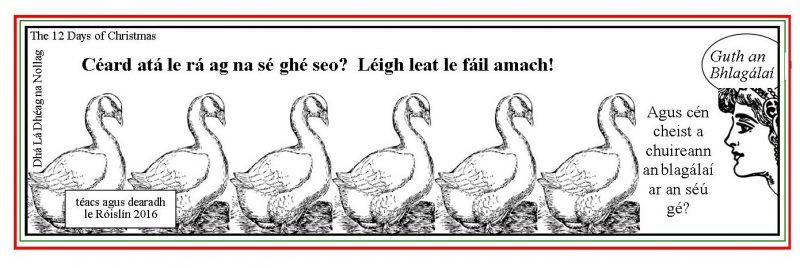
grafaicí: aghaidh mná / woman’s face: www.publicdomainpictures.net/view-image.php?image=157631&picture=woman-profile-portrait-clipart; gé / goose: http://www.clker.com/clipart-11902.html; téacs agus dearadh le Róislín, 2016
Now that we’ve reviewed a few general pronunciation tips for “Dhá Lá Dhéag na Nollag” (The 12 Days of Christmas, blagmhír 12/29), let’s look at dialóg na ngéanna as shown in the illustration from 12/27 (naisc do na blaganna thíos). For this post, I’ve separated out each goose with its own speech balloon, so it will be easier to gloss the sentences.
So, seo cuid cainte na ngéanna agus freagairt an bhlagálaí. Tá aistriúcháin agus leideanna fuaimnithe ann.

gé: http://www.clker.com/clipart-11902.html; téacs agus dearadh le Róislín, 2016-1
1)) Is muid na sé ghé atá ag breith. We are the six geese who are laying (eggs, of course).
The actual English from the song text (the phrase “a-laying”) is very colloquial from today’s perspective. Other than in this song (a-swimming, a-milking, etc.), we hardly ever use this structure in modern English, although it does show up occasionally, mostly in conjunction with other holiday or traditional activities (a-wassailing, a-Maying, a-nutting), or to quote Loretta Lynn’s song title from 1967, “Don’t Come Home a-Drinkin’ (with lovin’ on your mind).” Growing up in rural Kentucky in the 1930s, Lynn probably heard more of this “a-” + verb structure than most urban Americans would have at the time.
Reminder: This line is what I wrote for the goose to say as commentary. In the song, the phrase would simply be “sé ghé ag breith.” OK, not that geese really talk, but I guess is as realistic as any other story, cartoon, or comic that has a talking animal!
Pronunciation: sé ghé [shay yay, the “g” has become silent], breith [silent “t” and a short “e” sound for the “brei” part, like the “Bre-” of “Brexit.”
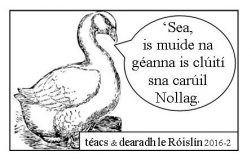
gé: http://www.clker.com/clipart-11902.html; téacs agus dearadh le Róislín, 2016-2
2)) ‘Sea, is muide na géanna is clúití sna carúil Nollag. The second goose agrees and adds, “We are the most famous geese in the Christmas carols.”
The word “muid” [mwidj] changes to “muide” [MWIDJ-uh] to show emphasis. “Is clúití” [KLOOitch-ee] here is the superlative form of “clúiteach” (famous). As with adjectives like “is tábhachtaí” and “is cleasaí,” the ending changes (switching to “-í” for words with slender root endings and to “-aí” for words with broad root endings).
And remember why “Nollaig” lost the letter “i”? Our old friend, an tuiseal ginideach. “Nollaig” becomes “Nollag” for phrases like “Daidí na Nollag,” “carúl Nollag,” “bronntanas Nollag,” and “Dhá Lá Dhéag na Nollag.”

gé: http://www.clker.com/clipart-11902.html; téacs agus dearadh le Róislín, 2016-3
3)) ‘Sea, agus ní raibh mé riamh róthógtha leis an líne sin, “Christmas is coming, the geese are getting fat.” The third goose comments, “Yes, and was never very fond of that line, “Christmas is coming, the geese are getting fat.” This line is, of course, from a different another carol (“Christmas Is Coming”).
Pronunciation: “raibh” can be pronounced “rev” (like “to rev” a car engine), “ruh” (like the “ru” of “rum”) or “row” (like “to row” a boat), depending on dialect. The prefix “ró-” causes “tógtha” to be lenited, becoming “róthógtha,” so we say “ROH-HOHG-huh;” note that both t’s are silent. There are two syllables to the word “líne” [LEEN-yuh], although it looks like the one-syllable English word “line.” For “i gcarúl,” the “c” is silent.
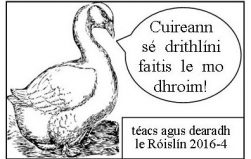
gé: http://www.clker.com/clipart-11902.html; téacs agus dearadh le Róislín, 2016-4
4)) Cuireann sé drithlíní faitís le mo dhroim. It sends shivers down my spine, lit. it puts twinges of fear with my back. So we’re not actually “sending” shivers “down” the “spine,” but “putting” them “with” the “back.” Same diff, if you’re the goose, I’d say.
Pronunciation: drithlíní [DRIH-leen-ee, the “t” is silent]; faitís (of fear): we don’t see this word all that often in the genitive case (sa tuiseal ginideach) but here it is — note that the ending has dropped the “o” (of the root form “faitíos,” fear), so now the ending is pronounced “eesh” because it has a slender “s.”
For the switch from “droim” to “dhroim,” following the word “mo” (my), please see the next note.
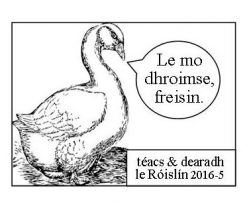
gé: http://www.clker.com/clipart-11902.html; téacs agus dearadh le Róislín, 2016-5
5)) Le mo dhroimse, freisin. Down my spine, also, lit. with my back, also.
Pronunciation: Here’s our old friend, the voiced velar fricative, that is, the “dh-” of “dhroim.” We’ve had many guides for pronouncing this guttural (“throaty”) sound previously in this blog (nasc amháin dóibh thíos). There’s no actual equivalent in English but you can find the sound in various other languages. Most recently I noted that it’s in the name of the amazing young singer “Amira Willighagen,” and the name of her hometown, Nijmegen. Now that I’ve become aware of the Dutch connection, I hear it also in the surname “Groot,” as in Boudewijn de Groot or Marike Groot. I never thought I’d be dealing with sloinnte Ollanacha in writing this blog, but you never know what will come up when you’re looking for sounds that aren’t in English!
The “-se” suffix is added to emphasize the comparison with the previous statement, that both geese experience the same feeling.
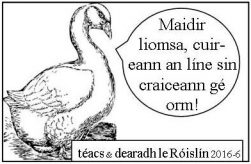
gé: http://www.clker.com/clipart-11902.html; téacs agus dearadh le Róislín, 2016-6
6)) Maidir liomsa, cuireann an líne sin craiceann gé orm. As for me, that line gives me goosebumps, lit. that line puts gooseflesh on me.
No special pronunciation challenges here, but remember that the broad “r” in “orm” is flapped (like a short light trill), so the word has two syllables, not one syllable like the Great Orme and the Little Orme in North Wales or the Orme School (in Arizona). The second syllable is due to the “uh” sound between the “r” and the “m,” much like what happens with the Irish English pronunciation of “film” (“fillum”).
In contrast, the “r’s” in “maidir” and “cuireann” are slender, so they are not flapped. Instead, they have a buzzy sound that I represent with “rzh” in my pronunciation guides [MADj-irzh for “maidir” and KwIRzh-un for “cuireann“]. In the standard International Phonetic Alphabet (IPA), it’s /rj/ and in the Irish-modified IPA, as laid out in the Foclóir Póca, it’s /r´/.
7)) This one is “guth an bhlagálaí” ([guh un VLAHG-awl-ee], the voice of the blogger), responding to
what the last goose said. “Hé! Craiceann gé? Cén dóigh is féidir le líne charúl Nollag craiceann gé a chur ort más gé cheart cheana féin thú? Hey! Goosebumps? How can a line of a Christmas carol give you goosebumps if you’re already a right goose? A little more literally, that’s “How can a line of a Christmas carol put gooseflesh on you if you’re already a right goose?”
In this sentence, we actually have a trio of sounds for “ch” — usually there are just two! The first, in “charúl” and “chur,” is “broad,” pronounced like the “ch” in German “Buch,” Yiddish/English “chutzpah.” and Welsh “bach/fach” or, just to quadruple it up for a fun velar fricative workout, “ei chlochen a’i chwch” (her bell-jar and her boat). The second “ch” sound, in “cheart,” is “slender,” pronounced like the “h” in “humid” or “human;” the “c” is actually silent. And finally, quite idiosyncratically, the “ch” of “cheana” is not pronounced like the “ch” of “cheart” but like the “h” of English “hat” or “hot,” so “cheana” is pronounced “hanuh” (IPA /hanə/). AFAIK, this is the only Irish word spelled with an slender initial “ch” where the “h” doesn’t have the “hy” sound of “humid” or “human.”
So that’s six geese a-sayin’ –oops– what the six geese a-layin’ are a-sayin’ agus mo fhreagairt. I hope you found it both fun and helpful for practicing Irish. Next up, cúig véarsa eile an amhráin (Lá 8, 9, 10, 11, agus 12 na Nollag). — Róislín
Naisc sa bhlag seo:
a)) Nasc maidir leis na cuimiltigh ghlóracha: Saying “I love you” in Irish and Minding Your Velar Fricatives Posted on Oct 9, 2011 (for the “dh” of “dhroim” and “dhroimse” and for thousands of other Irish words)
b)) Liosta carnach nasc (cumulative list of links) maidir le “Dhá Lá Dhéag na Nollag” sa bhlag seo, ag tosú le 2010:
2010: Dhá Lá Dhéag na Nollag (The Twelve Days of Christmas), Posted on 25. Dec, 2010
Cearca Francacha agus Lonta Dubha (Cuid a Dó don tSraith: Dhá Lá Dhéag na Nollag) Posted on 29. Dec, 2010
“Ór,” “Óir” or “Órga”? “Fáinne” or “Éan”? Éan?! (Cuid a Trí: Dhá Lá Dhéag na Nollag) Posted on 31. Dec, 2010
2011: Géanna agus Ealaí (Cuid a Ceathair: Dhá Lá Dhéag na Nollag) Posted on 04. Jan, 2011
Na hUimhreacha Pearsanta i nGaeilge (Irish Personal Numbers and Cuid a Cúig or the Last Installment of Dhá Lá Dhéag na Nollag) Posted on 06. Jan, 2011
2012: Bunuimhreacha, Orduimhreacha is Maoluimhreacha — A Thiarcais! (Oh my!) Posted on 25. Dec, 2012
2013: Speaking of Pigeons (Colúir) Posted on Dec 14, 2013
(Cé Mhéad Patraisc? Cé Mhéad Drumadóir? (or ’12 Lá na Nollag’ Redux and an Irish Counting Lesson to boot) Posted on 18. Dec, 2013
2015: The Irish Twelve Days of Christmas Redux Redux with a Blogliography of Other Blogs on the Song Posted on Dec 25, 2015
2016: Cén sórt éin? Cén sórt crainn? — Learning Irish from the Christmas Carol ‘Dhá Lá Dhéag na Nollag’ (12 Days of Christmas) Posted on Dec 20, 2016
Ar an 2ú agus an 3ú lá den Nollaig – dhá fhearán, trí chearc fhrancacha (2 turtledoves, 3 French hens, for the 2nd and 3rd days of Christmas) Posted on Dec 24, 2016
Ar an 4ú, an 5ú, an 6ú agus an 7ú lá den Nollaig (birds, rings, and poultry for the 4th, 5th, 6th, and 7th days of Christmas) Cuid/Part 1/2 Posted on Dec 27, 2016 (as it turned out, it’s really Part 1 of 3)
Ar an 4ú, an 5ú, an 6ú agus an 7ú lá den Nollaig (birds, rings, and poultry for the 4th, 5th, 6th, and 7th days of Christmas) Cuid / Part 2: Some Pronunciation Tips Posted on Dec 29, 2016

Build vocabulary, practice pronunciation, and more with Transparent Language Online. Available anytime, anywhere, on any device.





Leave a comment: